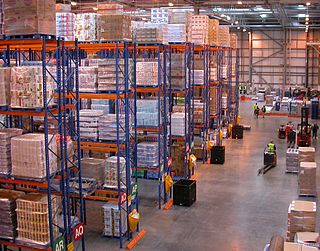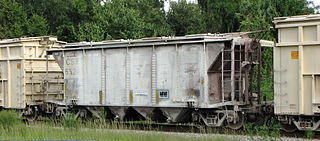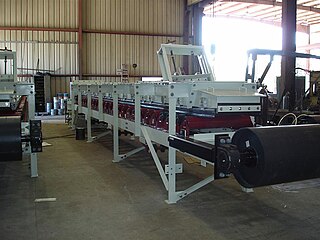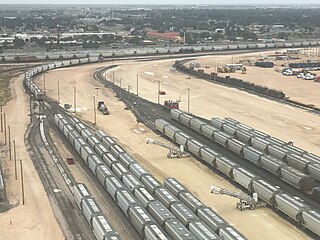A hopper car (US) or hopper wagon (UIC) is a type of railroad freight car used to transport loose bulk commodities such as coal, ore, grain, and track ballast. Two main types of hopper car exist: covered hopper cars, which are equipped with a roof, and open hopper cars, which do not have a roof.

A distribution center for a set of products is a warehouse or other specialized building, often with refrigeration or air conditioning, which is stocked with products (goods) to be redistributed to retailers, to wholesalers, or directly to consumers. A distribution center is a principal part, the order processing element, of the entire order fulfillment process. Distribution centers are usually thought of as being demand driven. A distribution center can also be called a warehouse, a DC, a fulfillment center, a cross-dock facility, a bulk break center, and a package handling center. The name by which the distribution center is known is commonly based on the purpose of the operation. For example, a "retail distribution center" normally distributes goods to retail stores, an "order fulfillment center" commonly distributes goods directly to consumers, and a cross-dock facility stores little or no product but distributes goods to other destinations.

A covered hopper is a self-clearing enclosed railroad freight car with fixed roof, sides, and ends with openings for loading through the roof and bottom openings for unloading. Covered hopper cars are designed for carrying dry bulk loads, varying from grain to products such as sand and clay. The cover protects the loads from the weather. Dry cement would be very hard to unload if mixed with water in transit, while grain would be likely to rot if exposed to rain.

A rotary car dumper or wagon tippler (UK) is a mechanism used for unloading certain railroad cars such as hopper cars, gondolas or mine cars. It holds the rail car to a section of track and then rotates the track and car together to dump out the contents. Used with gondola cars, it is making open hopper cars obsolete. Because hopper cars require sloped chutes in order to direct the contents to the bottom dump doors (hatches) for unloading, gondola cars allow cars to be lower, thus lowering their center of gravity, while carrying the same gross rail load. The "Double Rotary" coal gondola or coal hopper is required for compatibility.

Bulk cargo is commodity cargo that is transported unpackaged in large quantities.

A silo is a structure for storing bulk materials. Silos are used in agriculture to store fermented feed known as silage, not to be confused with a grain bin, which is used to store grains. Silos are commonly used for bulk storage of grain, coal, cement, carbon black, woodchips, food products and sawdust. Three types of silos are in widespread use today: tower silos, bunker silos, and bag silos.

The Port of Ashdod is one of Israel's three main cargo ports. The port is located in Ashdod, about 40 kilometers south of Tel Aviv, adjoining the mouth of the Lachish River. Its establishment significantly enhanced the country's port capacity. It handles the largest volume of cargo containers annually of all Israeli ports. Ships carrying humanitarian aid for the Gaza Strip also unload their cargo at Ashdod.

A variable rate feeder is a piece of industrial control equipment used to deliver solid material at a known rate into some process.

TAKRAF Group (“TAKRAF”) is a global German industrial company. Through its brands, TAKRAF and DELKOR, the Group provides equipment, systems and services to the mining and associated industries, with a focus on energy saving, lowering environmental impact and meeting operational requirements.

Rotary feeders, also known as rotary airlocks or rotary valves, are commonly used in industrial and agricultural applications as a component in a bulk or specialty material handling system. Rotary feeders are primarily used for discharge of bulk solid material from hoppers/bins, receivers, and cyclones into a pressure or vacuum-driven pneumatic conveying system. Components of a rotary feeder include a rotor shaft, housing, head plates, and packing seals and bearings. Rotors have large vanes cast or welded on and are typically driven by small internal combustion engines or electric motors.

A coal-fired power station or coal power plant is a thermal power station which burns coal to generate electricity. Worldwide, there are about 8,500 coal-fired power stations totaling over 2,000 gigawatts capacity. They generate about a third of the world's electricity, but cause many illnesses and early deaths, mainly from air pollution.

A conveyor system is a common piece of mechanical handling equipment that moves materials from one location to another. Conveyors are especially useful in applications involving the transport of heavy or bulky materials. Conveyor systems allow quick and efficient transport for a wide variety of materials, which make them very popular in the material handling and packaging industries. They also have popular consumer applications, as they are often found in supermarkets and airports, constituting the final leg of item/ bag delivery to customers. Many kinds of conveying systems are available and are used according to the various needs of different industries. There are chain conveyors as well. Chain conveyors consist of enclosed tracks, I-Beam, towline, power & free, and hand pushed trolleys.

Transloading, also known as cross-docking, is the process of transferring a shipment from one mode of transportation to another. It is most commonly employed when one mode cannot be used for the entire trip, such as when goods must be shipped internationally from one inland point to another. Such a trip might require transport by truck to an airport, then by airplane overseas, and then by another truck to its destination; or it might involve bulk material loaded to rail at the mine and then transferred to a ship at a port. Transloading is also required at railroad break-of-gauge points, since the equipment can not pass from one track to another unless bogies are exchanged.

A concrete plant, also known as a batch plant or batching plant or a concrete batching plant, is equipment that combines various ingredients to form concrete. Some of these inputs include water, air, admixtures, sand, aggregate, fly ash, silica fume, slag, and cement. A concrete plant can have a variety of parts and accessories, including: mixers, cement batchers, aggregate batchers, conveyors, radial stackers, aggregate bins, cement bins, heaters, chillers, cement silos, batch plant controls, and dust collectors.
Heyl & Patterson Inc. is an American specialist engineering company, founded in 1887 and based in Pittsburgh, Pennsylvania.

Open wagons form a large group of railway goods wagons designed primarily for the transportation of bulk goods that are not moisture-retentive and can usually be tipped, dumped or shovelled. The International Union of Railways (UIC) distinguishes between ordinary wagons and special wagons (F/6). Open wagons often form a significant part of a railway company's goods wagon fleet; for example, forming just under 40% of the Deutsche Bahn's total goods wagon stock in Germany.

A shiploader is a large machine used for continuously loading bulk solid materials such as iron ore, coal, fertilizers, grains and/or material in bags onto ships or barges. These machines are located in ports and jetties to facilitate bulk material exportation. Generally shiploaders are engineered to suit specific project requirements. Those requirements often include: port design, material characteristics, loading capacity, vessel type, local law, and budgetary limitations. A shiploader mainly consists of a central column, an extendable arm or boom, a belt conveyor extending out of the boom structure, a slewing mechanism, and a loading chute to transfer product from a source conveyor or feeder. The boom can move front and back, up and down by separate drives so that it can fill the whole breadth of the ship hold and adapt to the ships increasing draught while it is loaded.
AUMUND Fördertechnik GmbH, commonly known as Aumund, is a German producer of conveying technology and is headquartered in Rheinberg, district of Millingen. The company was founded in 1922 by Professor Heinrich Aumund and is today managed by his grandson, Franz-Walter Aumund. Aumund nowadays has around 390 employees, 10 branches worldwide and a wide network of local representatives.
A Helix Dumper is a rail transport and unloading solution, designed for continuous rolling discharge of bulk commodities. Originally developed for the iron ore industry, the Helix Dumper system can handle many types of fine-grained and potentially sticky commodities. When the Helix Dumper wagon enters the unloading area, a wheel at the top of the wagon makes contact with the spiral-shaped rigid guide that constitutes the unloading station. As the wheel travels along the path of the guide, the wagon chassis remains on the rails while the body of the wagon is rotated 148 degrees to dump its load. After the rotation, the direction of the guide changes and the wagon body is returned to its normal position. The Helix Dumper has a discharge rate of up to 25,000 tonnes per hour.
Transmin is an Australian privately owned company specialising in bulk materials handling equipment and related products headquartered in Malaga, Western Australia, 15 kilometres north of Perth, Western Australia, that provides engineered equipment, supplies and services to the mining-resources and bulk material handling industries, in Australia and overseas.
















